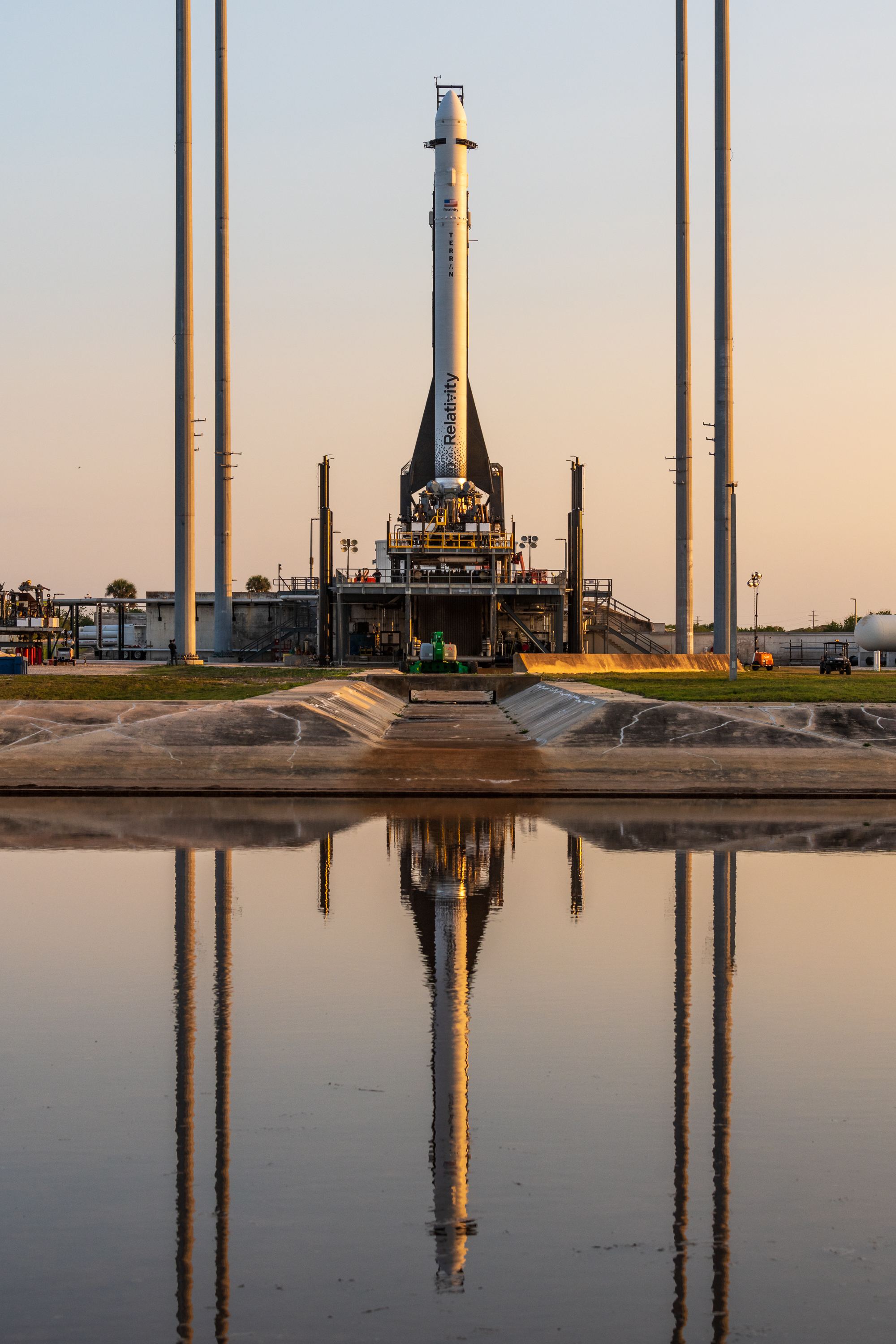Relativity Space scrubs debut launch attempt of world's 1st 3D-printed rocket after abort
The company plans to try again on Saturday (March 11).

The space startup Relativity Space called off the first-ever flight of its new 3D-printed rocket on Wednesday (March 8) after a last-minute abort and temperature issues during the countdown.
Relativity Space's Terran 1 launch vehicle, billed as the world's first 3D-printed rocket, experienced an automatic abort about 70 seconds before an initial launch try at 2:40 p.m. EST (1940 GMT) at its Florida launch pad at the Cape Canaveral Space Force Station.
While the company tried to reset for a second launch attempt on Wednesday, it ultimately had to stand down "due to exceeding launch commit criteria limits" for the fuel temperatures on the rocket's second stage, officials wrote in a Twitter update.
"We are scrubbing launch operations for the day, thanks for playing," the company's launch director said during the countdown.
Related: Relativity Space to launch satellite 'tugs' on 3D-printed rocket
"While we obviously had high hopes for sending our Terran 1 off today, we're going to continue to take a measured approach so we can ultimately see this rocket off to Max Q and beyond," Arwa Tizani Kelly, test and launch technical program manager for Relativity Space, said during live launch commentary. (Max Q refers to the period of maximum dynamic pressure on a rocket during launch.)
The company announced shortly after the scrub that it aims to try again this weekend.
Get the Space.com Newsletter
Breaking space news, the latest updates on rocket launches, skywatching events and more!
"Player ready? Yup. Our next launch attempt window is confirmed for this Saturday, March 11 from 13:00 – 16:00 ET. #GLHF," Relativity Space tweeted on Wednesday. (GLHF stands for "Good Luck, Have Fun," which is the name of the mission.)

Relativity Space's first Terran 1 mission is a shakedown flight for a 110-foot-tall (33-meter) rocket designed to launch small satellites into low-Earth orbit. The two-stage rocket is novel in that 85% of its structure by mass is 3D-printed, including its nine first-stage Aeon-1 engines, which are fueled by liquid methane in another U.S. orbital first.
Terran 1 is designed to carry payloads of up to 2,700 pounds (1,250 kilograms) to low Earth orbit and can haul 1,980 pounds (900 kg) to a sun-synchronous orbit at a cost of about $12 million per flight, Relativity Space has said. The company is also working on a larger, fully reusable rocket called Terran R designed to stand 216 feet tall (66 m) and launch more than 44,000 pounds (20,000 kg) to orbit with its Aeon-R engines starting in 2024.
"No matter the outcome tomorrow, we are still in the early innings of a 9-inning ballgame," Relativity Space CEO Tim Ellis wrote on Twitter before the Terran 1 launch attempt. "This launch won't singularly define our long-term success."
Ellis said he will be happy to see if Terran 1 can successfully pass through Max Q, since it will prove that the company's use of additive manufacturing technology to 3D-print rockets is viable.
"This launch will, however, provide us with useful data and insights that will make us better prepared for our next at-bat, and is a fantastic learning platform for developing technologies directly applicable to Terran R, giving us a lot of confidence we are ahead in the race to become the next great launch company," Ellis added. "Excited to show the world what we've got!"
Editor's note: This story was updated at 1:15 am. ET on March 9 with the new launch date of March 11.
Email Tariq Malik at tmalik@space.com or follow him @tariqjmalik. Follow us @Spacedotcom, Facebook and Instagram.
Join our Space Forums to keep talking space on the latest missions, night sky and more! And if you have a news tip, correction or comment, let us know at: community@space.com.

Tariq is the Editor-in-Chief of Space.com and joined the team in 2001, first as an intern and staff writer, and later as an editor. He covers human spaceflight, exploration and space science, as well as skywatching and entertainment. He became Space.com's Managing Editor in 2009 and Editor-in-Chief in 2019. Before joining Space.com, Tariq was a staff reporter for The Los Angeles Times covering education and city beats in La Habra, Fullerton and Huntington Beach. In October 2022, Tariq received the Harry Kolcum Award for excellence in space reporting from the National Space Club Florida Committee. He is also an Eagle Scout (yes, he has the Space Exploration merit badge) and went to Space Camp four times as a kid and a fifth time as an adult. He has journalism degrees from the University of Southern California and New York University. You can find Tariq at Space.com and as the co-host to the This Week In Space podcast with space historian Rod Pyle on the TWiT network. To see his latest project, you can follow Tariq on Twitter @tariqjmalik.
